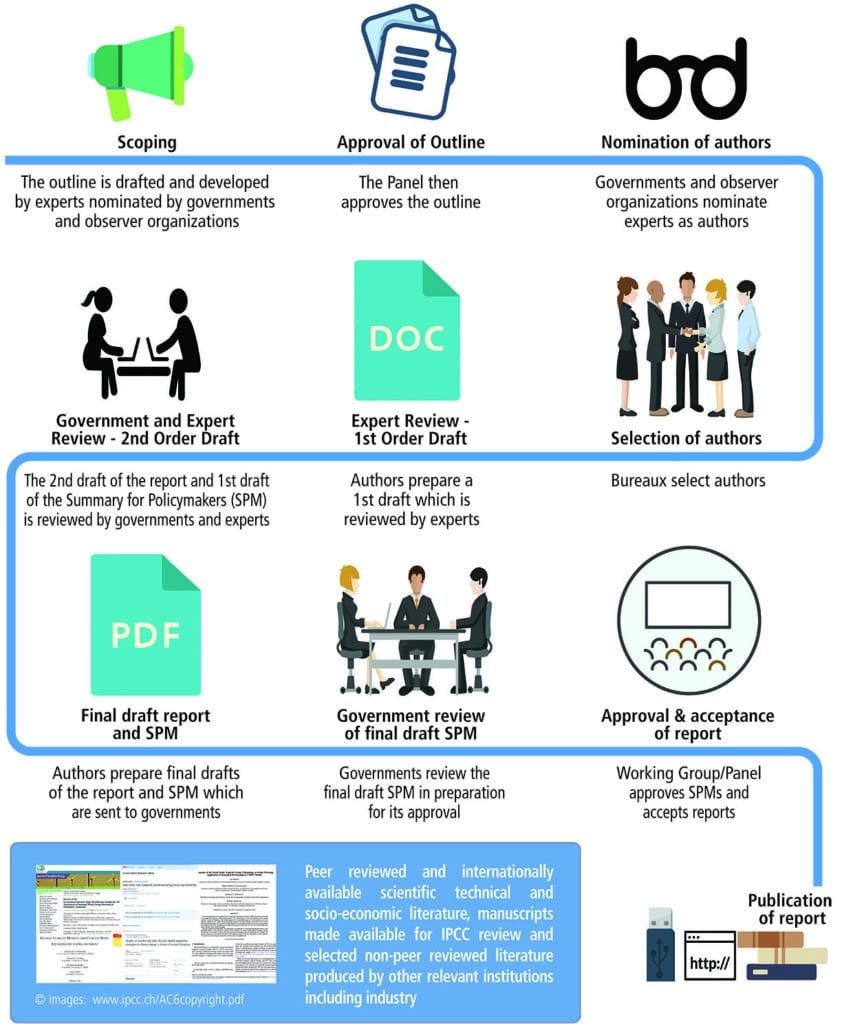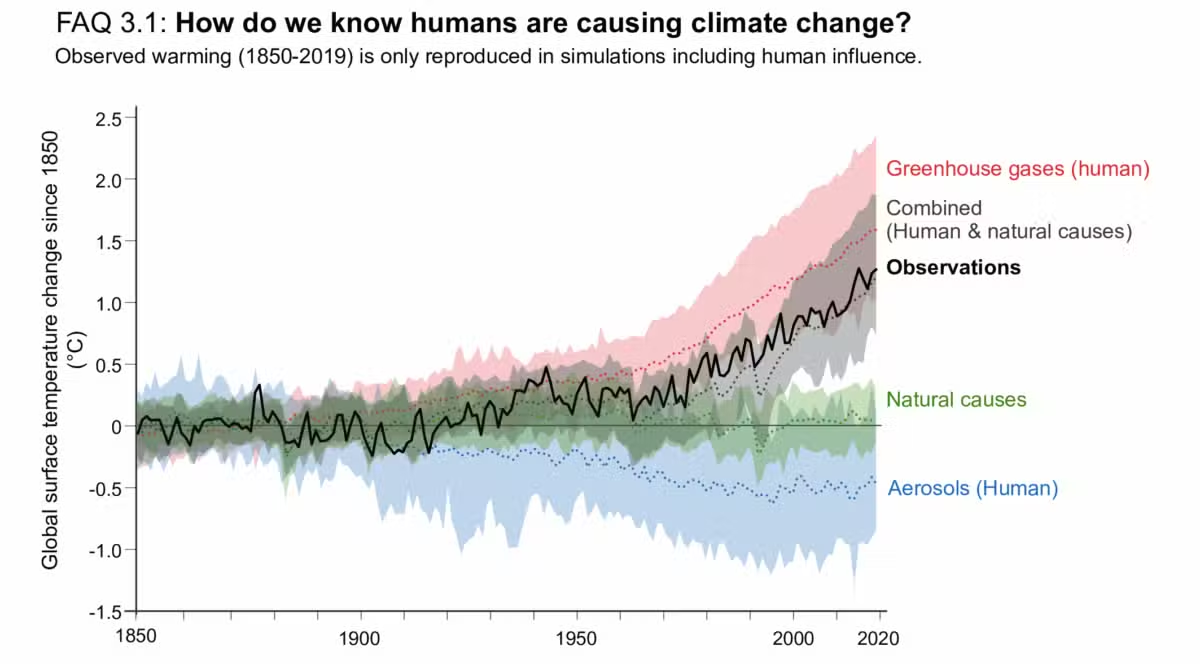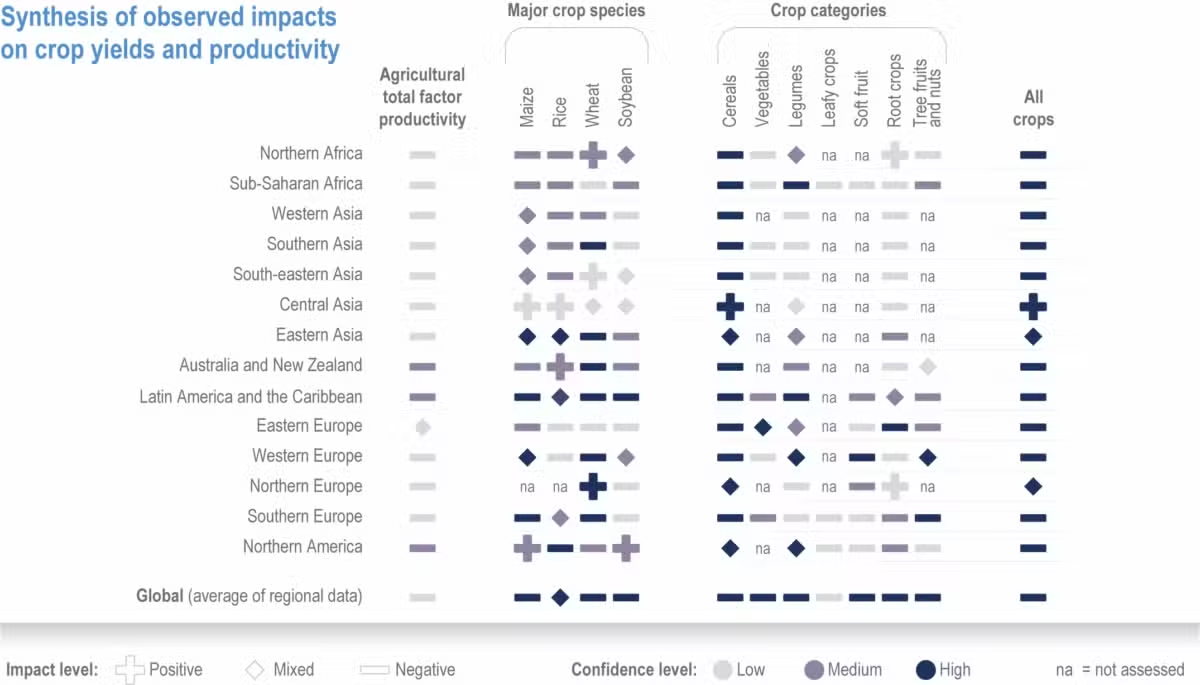- Climate
Misleading U.S. Department of Energy climate report chooses bias over science, climate scientists say
At the end of July 2025, the United States Department of Energy (U.S. DOE) published a report titled ‘A Critical Review of Impacts of Greenhouse Gas Emissions on the U.S. Climate’.
The report was written as the current U.S. administration proposed to overturn the Endangerment Finding – a 2009 Environmental Protection Agency (EPA) finding “that six greenhouse gases taken in combination endanger both the public health and the public welfare of current and future generations.”
So, 16 years after that finding, current EPA administrator, Lee Zeldin, announced a proposal to rescind it. According to an EPA press release on 25 July 2025: “If finalized, the proposal would repeal all resulting greenhouse gas emissions regulations for motor vehicles and engines”.
The EPA cited the DOE report as justification for its proposed rollback. The DOE report was written by five well-known climate contrarians – all of whom were hand-selected for the job by U.S. Secretary of Energy Chris Wright, per the foreword of the report.
In that document, the authors pretend to overturn well-established scientific methods and findings from a vast body of scientific evidence spanning several decades. They target highly-reputable organizations like the Intergovernmental Panel on Climate Change (IPCC) and the U.S. National Climate Assessment (USNCA) – the latter’s website can no longer be accessed as the U.S. government removed it.
Much of the criticism is aimed at IPCC reports – for context: the most recent IPCC assessment report was written and reviewed by 743 experts and is routinely cited as one of the most reputable and trustworthy sources of climate change information by leading climate scientists around the world.
By comparison, the DOE report has just five authors. This alone does not invalidate the report. But, as several climate scientists pointed out after the report was released, it does raise suspicions – especially when all five authors have records of publishing misleading information. Whereas IPCC reports follow a rigorous process of scoping, drafting, and review (Figure 1), there is no explicit or transparent process for the DOE report.

As Dr. Andrew Dessler, Prof of Atmospheric Sciences at Texas A&M University, wrote on Bluesky:
“The authors of this report are widely recognized contrarians who don’t represent the mainstream scientific consensus. If almost any other group of scientists had been chosen, the report would have been dramatically different. The only way to get this report was to pick these authors.”
To assess the report’s content – not just the background of its authors – Science Feedback contacted climate scientists with expertise in some of the key topics* in the report to review and comment on its scientific merit. The scientists are unanimous in explaining that this report is unscientific as it does not weigh all relevant evidence, and instead cherry-picks information to support a pre-determined conclusion. In addition, the report misrepresents the conclusions of research articles it cites, as some of their very authors explain below.
Science Feedback contacted the DOE to ask for more information about the reviewers and for more scientific background. A DOE spokesperson replied but did not provide additional information, simply claiming that the paper’s authors have “expertise in climate and atmospheric science, physical science, economics and academic research”. However, as we’ll show, many aspects of the report are at odds with science and decades of scientific evidence.
In the first section, we will highlight climate scientists’ assessments of the overall report, and in the second we detail the misleading aspects of the DOE report based on expert assessment and scientific evidence.
*Note: article will be updated as we receive more information and insights from climate scientists.
Main Takeaways:
- Scientists with expertise on climate explain that the recent DOE climate report cherry-picks information, misrepresents research findings, and overall is not a proper, nor scientific, assessment of climate change impacts.
- As a result, the report is biased toward understating the consequences of climate change and the confidence of scientists that these changes are mainly being driven by greenhouse gas emissions from human activities.
- Climate scientists also pointed out that all five of the report’s authors are known climate contrarians who have a history of sharing misinformation. This report shouldn’t be confused with work of scientific nature.
U.S. Department of Energy report cherry-picks information to misrepresent key climate change findings
DOE report misrepresents research findings
After the DOE report was published, climate scientists quickly began pointing out its flaws online – some scientists even called out the report for mischaracterizing their research findings. Below are comments from climate scientists who have spoken out on this:
Dr. Zeke Hausfather, Climate Research Lead at Stripe, explained the following in his article titled “How the DOE and EPA used and misused my research”:
“They [DOE report authors] scoured my paper on the performance of climate models to find the one figure (deep in the supplementary materials) to reinforce the point they were trying to make, and never actually referred to the broader conclusion of the paper that old models had by-and-large performed quite well. This is indicative of a deeper problem in the DOE report: it cherry-picks figures and parts of studies to support a preconceived narrative that minimizes the risk of climate change. In this case, the actual content of my paper went counter to the narrative they were trying to present, and thus was ignored.”
✝Note: the marked references are incorrect in the DOE report.
DOE report does not follow scientific methods
Several climate scientists have listed reasons that the DOE report is not a legitimate scientific report. One of the main reasons has to do with how the report was ‘reviewed’.
Typically, before a scientific paper is published in a high-ranking journal, it is peer-reviewed by experts in the study’s field who did not contribute to the paper. This process allows scientists to improve the quality of their work and helps prevent ‘bad science’ from being published.
Instead of an external peer-review – which, again, is the standard for publishing reputable scientific papers – the DOE report was only checked by “a team of anonymous DOE and national lab reviewers”.
The DOE report does not state how its ‘reviewers’ were chosen, nor whether they possess the relevant expertise to conduct such a review. The quality of its review is, therefore, highly questionable and is certainly not a legitimate external peer review, as climate scientists have pointed out.
Evaluation of select key topics discussed in the DOE report
CO2’s role in global warming compared to other factors
Key takeaway
The evidence for CO2 as a greenhouse gas is well-established[4,5,6] and is built on a body of scientific evidence that started around 1856 and has been growing for over a century. While the DOE report correctly states that CO2 is a greenhouse gas that affects our atmosphere, it excludes key findings from a vast body of scientific evidence that shows recent global warming has been driven by rising concentrations of CO2 from human activities[4]. Instead of providing this evidence, the DOE overstates the uncertainties about the role of other factors affecting Earth’s climate, like solar activity. Other factors – both warming and cooling – have already been assessed in robust climate assessments like the IPCC Sixth Assessment Report[4]. Scientific evidence shows that solar activity has had a negligible effect on recent warming (figure 2)[4].

DOE report quote: “Substantive criticism of the main IPCC assessments of the role of CO2 in recent warming focus on inadequate assessment of natural climate variability, uncertainties in measurement of solar variability and in aerosol forcing, and problems in the statistical methods used for attribution.”
Implied claim: ‘CO2’s role in recent warming is not well-established, and other factors like solar variability are not properly accounted for.’
Claim verdict(s): Inaccurate and misleading

Cathy Clerbaux
Senior Scientist, Laboratoire Atmosphères, Milieux, Observations Spatiales (LATMOS)/Institut Pierre Simon Laplace (IPSL)
They show that numerical models do a poor job of predicting rising temperatures, but they don’t show the temperatures themselves. Their message: you can’t trust the models. In response, we can say that we trust thermometers + current satellite measurements, which show that temperatures are rising almost everywhere. Model simulations don’t allow us to explain this increase in any other way than by the accumulation of CO2. All models agree on this finding, even if they don’t all show exactly the same thing (e.g. because clouds remain difficult to model).

François-Marie Bréon
Deputy Director, Laboratoire des sciences du climat et de l’environnement
There is no doubt among the scientific community that the increase in greenhouse gases in the atmosphere, particularly CO2 and methane, is the main cause of the global warming observed over the last 50 years. There are uncertainties about the exact quantification of the impacts, particularly due to climate sensitivity and the cooling effect of aerosols, but these uncertainties cannot call into question the main influence of greenhouse gases.
The emphasis on uncertainties in the report is based on fallacious arguments, a biased reading of certain articles, and the use of mediocre articles in marginal literature. In particular, there is no mechanism that can explain more than a negligible part of the sun’s influence on recent warming.

Joanna Haigh
Emeritus Professor, Imperial College London
General: ‘Uncertainty’ is fundamental to scientific analysis and does not imply lacking knowledge or expertise. Indeed, assessment of uncertainties in data analysis and modelling provides a measure of confidence in any conclusions. Throughout its reports the IPCC provides careful assessments of uncertainties, which of course are much larger for some factors than others.
Specific: The DOE report provides discussion of many important and relevant issues but it is selective in its analysis and conclusions. For example, it claims solar forcing is a major uncertainty, whilst carefully avoiding discussion of global temperature trends since around 2000 which have continued to increase sharply while total solar irradiance has declined. Note a new article by Amdur & Huybers (2025)[7]. (DOE discussion on both solar forcing and climate sensitivity relies heavily on the papers of Nicola Scafetta which have been roundly debunked).
The 2025 paper that Haigh references above was published in PNAS – a highly-ranked peer-reviewed journal. The study suggests that since 1980, total solar irradiance (TSI) – which is a measure of how much solar energy a given area of our atmosphere receives – has decreased more per decade than commonly estimated[7]. The authors of the PNAS paper explain that this, in turn, implies that humans have been playing a greater role in recent warming than previously estimated[7]. The DOE report authors exclude recent peer-reviewed papers, such as the one that Haigh references, that would conflict with the narrative they try to uphold with older papers of lower quality (one is debunked here). This is a clear example of the DOE report’s non-scientific approach to weighing and presenting evidence.
CO2’s ‘greening effect’ compared to negative climate impacts
Key takeaway
The DOE report highlights the fertilizing effect of CO2 on vegetation, while omitting the other – harmful – effects of rising CO2. This fallacious reasoning is designed to suggest that rising atmospheric CO2 is a good thing.
The greening of the planet is a well-documented phenomenon[8]. It is not homogeneous: we’ve observed more of it at high latitudes and in temperate regions of the Northern Hemisphere. Greening is explained by rising CO2 levels –which increase plant photosynthesis and hence biomass – and human activities, particularly reforestation and intensive agriculture[8].
But the rise of atmospheric CO2 is also causing global warming that can harm plants[4], as summarized by IPCC[9]: “Climate change has already affected food security due to warming, changing precipitation patterns, and greater frequency of some extreme events (high confidence).” Indeed, those effects partly offset the fertilizing effect of CO2 on vegetation.
Finally, does increase in CO2 levels really “increase agricultural productivity” like the DOE report states? Studies combining all CO2 impacts show that crop yields and nutritional quality are declining at global scale. This also applies to North America, where total factor productivity – the ratio between agriculture outputs and the inputs to produce them – has already fallen (Figure 3).

DOE report quote: “Elevated concentrations of CO2 directly enhance plant growth, globally contributing to “greening” the planet and increasing agricultural productivity”
Implied claim: CO2 is beneficial because it can increase agriculture productivity and make Earth ‘greener’ (increased vegetation).
Claim verdict(s): Misleading

David Lobell
Associate Professor, Stanford University
I see 2 main problems with this (very old) argument.
- The direct benefits of CO2 are widely acknowledged and nothing new. But we know that elevated CO2 leads to climate changes, and so the question is whether the CO2 benefits are big enough to offset the climate losses. Their report does not address the net effects, which many studies have shown are negative, even for the U.S.
- The numbers they cite for direct effects of CO2 are mainly from co2science.org, which is not a reputable source. Their summaries are not peer reviewed and include many studies of pots in greenhouses which are known to be biased. The numbers cited in the report are more than 2x what the best literature shows, such as in Ainsworth & Long (2021)[10]

Delphine Deryng
Lead Author IPCC AR6 WGII,
It is beneficial to an extent but one has to consider all direct and indirects aspects of rising CO2 and its effect on climate change.
[Higher CO2 level] does [increase vegetation] but as described [below], other risks come into play and become more dangerous as certain tipping points in the earth system are crossed (e.g., melt of arctic ice sheet, influencing general atmospheric and ocean circulation patterns).
Elevated atmospheric concentration enhances [the] rate of photosynthesis and reduces water transpiration from plant stomata. These combined effects stimulate plant growth, especially for plants following a C3 photosynthetic pathway (e.g., wheat). These effects increase agricultural productivity to a certain extent but, rising GHG emissions contribute to increased frequency and intensity of extreme weather events, negatively impacting plant and crop growth, and yield, such as risk of extreme heat stress occurring at crop anthesis. The positive effects of elevated CO2 on agricultural production will also saturate and in addition, create a change in the nutritional quality of grains.

Ehsan Eyshi Rezaei
Agricultural Scientist, Leibniz Centre for Agricultural Landscape Research (ZALF)
Elevated atmospheric CO2 can significantly stimulate photosynthesis, enhance water-use efficiency, and, under optimum management conditions, boost biomass production and yields, particularly for C3 crops (e.g., wheat, rice), while also increasing leafy biomass in wild ecosystems. Yield benefits for C4 crops (e.g., maize) are generally minimal and tend to become apparent primarily under drought conditions[10]. Yet the benefit is modest, highly conditional, and quickly outweighed by the very warming[11], drought[12], flooding[13], amplified pest-disease outbreaks[14], and extreme weather volatility that elevated CO2 simultaneously drives. The most recent study on this domain showed that without proper adaptation, even with CO2 fertilization, global calorie production from the six major staple crops declines by about 2.0–2.5% per 1°C increase in global mean surface temperature[15]. Moreover, extra CO2 lowers protein and micronutrient density in grains, so calories gained often come with poorer nutrition[16]. In short, while higher CO2 can help plants under ideal conditions, the package of climate impacts it unleashes overwhelms those gains long before mid-century, so it is emphatically not a reason to relax about rising emissions.
Extreme weather events
Key takeaway
As explained by the IPCC, “It is an established fact that human-induced greenhouse gas emissions have led to an increased frequency and/or intensity of some weather and climate extremes since pre-industrial time, in particular for temperature extremes.”[4] When summarizing climate scientist’s understanding about extreme weather events, authors of the DOE report focus only on historic trends and exclude a discussion of theories and models. Observational data tells us what happened in the past, but theory and models can help us understand the underlying driving forces and behavior of weather phenomena. Theory, models, and observational data are all important aspects of understanding how climate change impacts extreme events. By excluding this discussion in the DOE report, the authors understate what scientists know about how certain weather events will increase and/or intensify as Earth continues warming.
DOE report quote: “Extreme convective storms, hurricanes, tornadoes, floods and droughts exhibit considerable natural variability, but long-term increases are not detected.
Implied claim: ‘We don’t have statistically significant evidence that climate change has actually intensified extreme weather.’
Claim verdict(s): Misleading

Kerry Emanuel
Professor Emeritus of Atmospheric Science, MIT
Overall assessment: In general, the authors confuse signal detection with risk assessment. The latter brings into play ALL evidence, including theory and models, and accounts for uncertainty in theory, models, and observational data. There are many published papers that do this more or less correctly, but these are ignored in the DOE report. I found the section of the report that I reviewed [personally read through], the section on extreme events, disappointing and, in places, misleading.
Details: I have read through parts of the report, including the section on tropical cyclones. I found the section odd, and in places misleading or just wrong. I will focus my remarks on parts of Section 6 of the report.
The authors begin sensibly, in the Introduction, stating that: ‘Climate is about the statistical properties of weather over decades, not single events. Further, there are only about 130 years of reliable observational records that can be analyzed statistically. That brief interval does not begin to contain all the extreme events that the climate system can create on its own.’
It is odd, then, that they proceed to present time series of even shorter length and claim not to find trends of extreme events in them, thereby leading the reader to conclude that there are no underlying trends. They should have just stuck with their original statement and made the correct conclusion that observations usually do not suffice to detect extreme event trends of the predicted magnitude, and then turned to an exposition of what theory and models have to say. It is very odd that there is almost no mention of theory and models [for] extreme events. […]
Global climate data clearly and unequivocally show this bound increasing in virtually all of the tropical cyclone genesis regions. And, contrary to the statement in the DOE report, an upward trend in the proportion of very strong hurricanes HAS been detected and published. But instead of citing any of this, these authors violate their own introductory statement by citing short and generally unreliable records. For example, they state correctly that there is no detectable trend in continental U.S. hurricane landfalls. But at an average of 3 landfalling storms per year, there are not nearly enough data to detect a trend of the predicted magnitude. Given that the Caribbean region had a high population density (and associated newspaper accounts) going back to the early 19th century, they could have looked at ALL Atlantic landfalls, not just the U.S. Had they done so, they would have discovered a clear upward trend.
Climate change and wildfires
Key takeaway
Wildfires spark when conditions are right – i.e. hot, dry, and windy weather – and when there’s enough plant material to burn. As the DOE report does point out, human intervention can successfully stop small fires from escalating into megafires. Furthermore, there is evidence that, today, the area burned by wildfires each year is trending downwards, because humans are converting more and more natural vegetation into farmland[17].
However, these trends have occurred despite climate change, not because climate change has no effect. Climate change increases the risk of the hot and dry weather that exacerbates fires, and the IPCC found “medium confidence” that this sort of weather has become more probable in the U.S. over the past century[18]. We can see climate change’s effects when we zoom into certain regions, like the western U.S. – something the DOE report ignores.
The DOE report cherry-picks U.S.-wide data, ignoring the fact that the western U.S. is experiencing a wildfire surge. For instance, between 1972 and 2018, the annual area burned by California’s wildfires increased at least fivefold on average[19,20]. A 2025 paper (which we have covered) found that the increase in wildfires in Western North America is overwhelmingly due to climate change[21].
DOE report quote: “the number of fires [in the U.S.] is not increasing. The area burned did increase but only until about 2007.”
Implied claim: ‘Other human actions, like forest management practices, have impacted U.S. wildfire activity, but not climate change.’
Claim verdict(s): Lacks context

A. Park Williams
Professor, University of California, Los Angeles
The report’s section on wildfire lumps the entire US together, smearing out what’s going on in the western contiguous US despite the fact that it’s the rapidly increasing western US wildfire activity that necessitates this report’s wildfire section in the first place.
- On whether the area burnt in U.S. forest fires has not increased:
This is absolutely not the case in the western US, which is again the region that motivates most concerns about wildfire trends in the US. In the western US the annual area burned has tripled over the past 40 years, driven by a 10-fold increase in annual forest-fire area and a doubling of area burned in non-forest. The western US forest-fire area in 2020 nearly doubled the previous modern record (from 2012) and then 2021 nearly matched 2020. The increase in area burned did not come even close to ending in 2007 in the western US.
- On whether fire management practices are responsible for U.S. wildfire trends:
Beginning roughly a century ago the widespread implementation of fire-suppression policies allowed people to effectively take control of wildfire in the western US, but over the past several decades the annual area burned has quickly escalated despite ever intensifying and efforts toward fire suppression. That is, today’s concern over wildfire shouldn’t depend on how fires of today compare to those of the pre-suppression era, but should instead be related to how the rapidly increasing wildfire sizes in the western US today are occurring despite society’s best efforts to avoid such a trend. Further, it’s not simply the growing sizes of fires that are of concern. Fire size is simply easy to measure reliably. But as fires have grown larger, they have increasingly put people and property in the paths of flames, had such a negative impact on air quality that trends toward cleaner air since the 1980s have reversed even across much of the eastern US, and rapid increases in the extents of forest area burning at high severities have endangered many forest ecosystems despite fire being a natural ecosystem process.

Daniel Swain
Climate Scientist, University of California Agriculture and Natural Resources, Los Angeles
To Science Feedback in a 2020 article:
While the legacy of 20th century forest management policies, as well as urban incursion into the wildlands, are indeed relevant in some areas, research has shown that such non-climate factors cannot account for the enormous increase in area burned by wildfire both in the broader American West and California specifically.
Ocean acidification and the Great Barrier Reef
Key takeaway
When Earth’s oceans absorb CO2 from the atmosphere, ocean water reacts with the CO2 to form carbonic acid. As CO2 levels in the atmosphere have risen, the pH of the oceans has steadily dropped for the past several decades. A lower pH means a substance is more acidic, so scientists call this trend ‘ocean acidification’.
The DOE correctly reports that the oceans were more acidic in the prehistoric past[22]. However, the report then claims that marine life can adapt to ocean acidification. This claim ignores the fact that the oceans are acidifying far more rapidly – whereas their pH naturally varies by ±0.1 over 420,000 years[23], current trends result in pH dropping by 0.1 in just 60 years.
The report’s claim is also at odds with plentiful scientific evidence that falling pH levels have debilitating effects on all sorts of marine life, including coastal ecosystems, fishes, plankton, and coral reefs[24,25]. Corals are especially vulnerable. It’s well-understood that ocean acidification tends to weaken the calcium-based skeletons that corals build for their protection[26], just as vinegar dissolves limescale. In itself, this does not lead to coral bleaching – events when corals lose their color-giving algae, making them more vulnerable to disease – but it does leave them weaker in the face of a violent event like a cyclone.
A cyclone is precisely what struck Australia’s Great Barrier Reef in 2024, helping trigger a mass coral bleaching event. The DOE’s data on the Great Barrier Reef ends in 2023, before this mass bleaching occurred. On 6 August 2025, after the DOE report’s release, the Australian Institute of Marine Science – whose team monitors the Great Barrier Reef’s health – released an updated report showing that all sections of the Reef suffered significant coral cover losses.
DOE report quote: “[Elevated CO2 levels] also make the oceans less alkaline (lower the pH). That is possibly detrimental to coral reefs, although the recent rebound of the Great Barrier Reef suggests otherwise […] ocean biota appear to be resilient to natural long-term changes in ocean pH since marine organisms were exposed to wide ranges in pH.”
Implied claim: ‘Ocean acidification isn’t a threat to marine life, and the Great Barrier Reef is in good health.’
Claim verdict(s): Misleading

Fredrik Jutfelt
Professor, University of Gothenburg
The DOE report has cherry picked studies showing only minor effects of ocean acidification and heat waves, while ignoring many other studies that document stronger and more negative impacts of the climate stressors. It is therefore unscientific and highly biased. Had a student written this as a report, I would have criticised the selective reporting and that they have misrepresented the state of knowledge in the field of climate change impacts on biological systems. I would have given them a very low grade because I expect impartiality in science.
[…]
In the case of ocean acidification, the DOE report highlights a few studies that do not show negative effects of rising CO2 levels, yet fail to reference the vast body of literature demonstrating negative impacts on ocean organisms in terms of calcification rates, growth, fecundity, survival, and other impacts.
Sea level rise
Key takeaway
The rise in global mean sea level is one of the clearest indicators of climate change due to human activities[27]. As glaciers and ice sheets melt, they spill water into the oceans, and as ocean water warms, its volume expands[28]. We know that global sea levels have therefore risen around 23 cm (9 in) since the early 20th century, and we know this rise has accelerated in recent decades[29].
Rising seas are already placing coastal ecosystems and populations at risk, but, as the DOE report does say, it isn’t the only factor affecting coastlines[28]. The IPCC states: “Attributing such impacts to SLR [sea level rise], however, remains challenging due to the influence of other climate-related and non-climatic drivers such as infrastructure development and human-induced habitat degradation.”
Humans can change coastlines by building sea walls or creating artificial islands. Humans can also cause subsidence, sinking ground, by building atop it or depleting groundwater[30-31]. As coastal inhabitants largely live in subsiding locations, they sink as surrounding seas rise, and they experience an average relative sea level rise up to four times faster (around 8 mm per year)[32]. Climate change is still playing a role.
The DOE report’s analysis is incomplete. The report cherry-picks five coastal locations in the U.S. and only calculates the effects of one factor: subsidence. The report does not attempt to account for other locations or other factors – such as, indeed, climate change. The DOE report doesn’t invalidate a well-supported observation: global mean sea level is rising because of climate change.
DOE report quote: “Observed and predicted rates of mean global sea level rise might have little scientific relevance for specific locations, owing to local processes.”
Implied claim: Global sea level rise is not an issue in the U.S., because other factors – like the land sinking – are driving rising sea levels across many locations in the U.S.
Claim verdict(s): Misleading

Gonéri Le Cozannet
Researcher and IPCC AR6 co-author,
The sea level section of this report examines a few local tide gauge series, ignoring altimetry observations which clearly show an acceleration of the global sea level. It examines projections up to 2050, ignoring the fact that sea level will continue to rise beyond that date. The only cause of sea-level rise that is actually mentioned is land subsidence, while factors linked to climate change – thermal expansion of the oceans, melting of mountain glaciers and ice caps – are not examined. The question of uncertainties is mobilized solely to instill doubt about the reality of sea-level rise, whereas in the scientific community the question of uncertainties concerns greenhouse gas emissions on the one hand, and the speed of Antarctica’s response to this warming on the other.
Overall, this is a lazy analysis in which the authors have simply taken anecdotal evidence and passed under silence the essential to instill doubt about the reality of sea level and the significance of its impacts. This analysis has no value in scientific terms, is not aligned with the scientific consensus, and aims only to create confusion in order to delay or compromise action in favor of climate change adaptation and mitigation.
Updates:
- 6 Aug. 2025: The article was updated to include the response we received from a DOE spokesperson (added in the 10th paragraph).
- 8 Aug. 2025: The article was updated to include a section about ocean acidification and to add comments from Dr. Fredrik Jutfelt.
- 14 Aug. 2025: The article was updated to include a section about sea level rise and to add comments from Dr. Gonéri Le Cozannet.
References:
- 1 – Saltzman et al. (2017) Availability, production, and consumption of crops biofortified by plant breeding: current evidence and future potential. Annals of the New York Academy of sciences
- 2 – Ebi et al. (2021) Hot weather and heat extremes: health risks. The Lancet
- 3 – Seager et al. (2018) Whither the 100th Meridian? The Once and Future Physical and Human Geography of America’s Arid–Humid Divide. Part I: The Story So Far in. Earth interactions
- 4 – IPCC (2023) Climate Change 2023: Synthesis Report. Sixth Assessment Report of the Intergovernmental Panel on Climate Change
- 5 – Raghuraman et al. (2023) Greenhouse Gas Forcing and Climate Feedback Signatures Identified in Hyperspectral Infrared Satellite Observations. Geophysical Research Letters.
- 6 – Zhong & Haigh (2013) The greenhouse effect and carbon dioxide. Weather
- 7 – Amdur & Huybers (2025) Negative trend in total solar irradiance over the satellite era. Earth, atmospheric and planetary sciences
- 8 – Piao et al. (2019) Characteristics, drivers and feedbacks of global greening. Nature reviews earth and environment.
- 9 – IPCC (2019) Summary for Policymakers. In: Climate Change and Land: an IPCC special report on climate change, desertification, land degradation, sustainable land management, food security, and greenhouse gas fluxes in terrestrial ecosystems.
- 10 – Ainsworth & Long (2021) 30 years of free‐air carbon dioxide enrichment (FACE): What have we learned about future crop productivity and its potential for adaptation? Global Change Biology.
- 11 – Zhu et al. (2022) Warming reduces global agricultural production by decreasing cropping frequency and yields. Nature climate change.
- 12 – Stella et al. (2021) Methodology to assess the changing risk of yield failure due to heat and drought stress under climate change. Environmental research letters.
- 13 – Furtak & Wolinska (2023) The impact of extreme weather events as a consequence of climate change on the soil moisture and on the quality of the soil environment and agriculture – A review. CATENA.
- 14 – Singh et al. (2023) Climate change impacts on plant pathogens, food security and paths forward. Nature reviews microbiology.
- 15 – Hultgren et al. (2025) Impacts of climate change on global agriculture accounting for adaptation. Nature.
- 16 – Taub et al. (2008) Effects of elevated CO 2 on the protein concentration of food crops: a meta-analysis. Global change biology.
- 17 – Andela et al. (2025) A human-driven decline in global burned area. Science.
- 18 – IPCC (2021) Weather and Climate Extreme Events in a Changing Climate. In: Climate Change 2021: The Physical Science Basis.
- 19 – Williams et al. (2019) Observed Impacts of Anthropogenic Climate Change on Wildfire in California. Earth’s Future.
- 20 – Turco et al. (2023) Anthropogenic climate change impacts exacerbate summer forest fires in California. Proceedings of the National Academy of Sciences (PNAS).
- 21 – Queen et al. (2025) Fingerprint of anthropogenic climate change detected in long-term western North American fire weather trends. Nature Communications Earth and Environment.
- 22 – Halevy & Bachan (2017) The geologic history of seawater pH. Science.
- 23 – Hoegh-Guldberg et al. (2017) Coral Reef Ecosystems under Climate Change and Ocean Acidification. Frontiers in Marine Science.
- 24 – IPCC (2022) Changing Ocean, Marine Ecosystems, and Dependent Communities. In: Special Report on the Ocean and Cryosphere in a Changing Climate.
- 25 – Clements et al. (2022) Meta-analysis reveals an extreme “decline effect” in the impacts of ocean acidification on fish behavior. PLOS Biology.
- 26 – Fabricius et al. (2020) Progressive seawater acidification on the Great Barrier Reef continental shelf. Scientific Reports.
- 27 – Hamlington et al. (2024) The rate of global sea level rise doubled during the past three decades. Communication Earth & Environment.
- 28 – IPCC (2019) Sea Level Rise and Implications for Low-Lying Islands, Coasts and Communities. In : IPCC Special Report on the Ocean and Cryosphere in a Changing Climate.
- 29 – Hamlington at al. (2025) Sea level rise in 2024. Nature reviews Earth & Environment.
- 30 – Bagheri-Gavkosh et al. (2021) Land subsidence: A global challenge. Science of the Total Environment.
- 31 – Wu et al. (2022) Subsidence in Coastal Cities Throughout the World Observed by InSAR. Geophysical Research Letters.
- 32 – Nicholls et al. (2021) A global analysis of subsidence, relative sea-level change and coastal flood exposure. Nature Climate Change.



